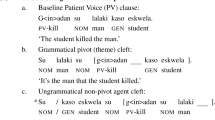Abstract
This commentary primarily addresses Gärtner’s critique of the “pseudo-cleft” analysis for Malagasy. First, it is shown that this analysis is almost certainly correct for focus constructions in three other Western Malayo-Polynesian languages. Next, it is shown that certain unexpected semantic patterns observed in Malagasy (including the potential for strong quantifiers to occur within the focused predicate phrase, and the non-entailment of exhaustivity) hold in these other languages as well. Thus, the semantic arguments against the pseudo-cleft analysis for Malagasy are not conclusive. Finally, on the basis of comparative evidence from Tagalog, it is suggested that the structure of adjunct-focus in Malagasy may actually be quite different from that of subject-focus, even though both constructions must satisfy the same morphological constraints.
Similar content being viewed by others
References
Alsagoff, Lubna. 1991. Topic in Malay: The other subject. PhD dissertation, Stanford University.
Aspillera, Paraluman S. 1969. Basic Tagalog for foreigners and non-Tagalogs. Rutland: Charles E. Tuttle Co.
Cole, Peter, Gabriella Hermon, and Norhaida bt. Aman. (to appear). Clefted questions in Malay. In Malay/Indonesian linguistics, eds. Orin Gensler and David Gil. London: Curzon Press.
Dik, C. Simon, Maria E. Hoffmann, Jan R. de Jong, Sie I. Djiang, Harry Stroomer, and Lourens de Vries. 1981. On the typology of focus phenomena. In Perspectives on functional grammar, eds. Teun Hoekstra, Harry van der Hulst, and Michael Moortgat, 41–74. Dordrecht: Foris.
Gärtner, Hans-Martin. 2009. On the prospects of a clause combining approach to “focusing” no-constructions in Malagasy. Natural Language & linguistics Theory. doi:10./1007/s11049-009-9077-1.
Hedberg, Nancy, and Lorna Fadden. 2007. The information structure of it-clefts, wh-clefts and reverse wh-clefts in English. In The grammar-pragmatics interface, eds. Nancy Hedberg and Ron Zacharski, 49–76. Amsterdam: John Benjamins.
Horn, R. Laurence. 1981. Exhaustiveness and the semantics of clefts. Proceedings of NELS 11: 125–142.
Kaufman, Daniel. 2005. Aspects of pragmatic focus in Tagalog. In The many faces of Austronesian voice systems: some new empirical studies, eds. I Wayan Arka and Malcolm Ross. Pacific Linguistics 571: 175–196. Canberra: ANU.
Keenan, Edward. 1987. A semantic definition of ‘indefinite NP’. In The representation of (in)definiteness, eds. Eric Reuland and Alice ter Meulen, 286–317. Cambridge: MIT.
Kroeger, Paul. 1993. Phrase structure and grammatical relations in Tagalog. Stanford: CSLI Publications.
Kroeger, Paul. 1998. Clitics and clause structure in Tagalog. In Pagtanaw: Essays on language in honor of Teodoro A. Llamzon, ed. Lourdes S. Bautista, 53–72. Manila: Linguistic Society of the Philippines.
Kroeger, Paul. 2005. Kimaragang. In The Austronesian languages of Asia and Madagascar, eds. Sander Adelaar and Nikolaus Himmelmann, 397–428. London/New York: Routledge.
Kroeger, Paul. 2007. The syntactic distribution of ‘modal particles’ in Kimaragang Dusun. Paper presented at Beyond ‘Focus’ and Ergativity: Towards a more comprehensive view of Austronesian morphosyntax conference, 13–15 Sept. 2007. Zentrum für Allgemeine Sprachwissenschaft, Typologie und Universalienforschung, Berlin.
Lambrecht, Knud. 1994. Information structure and sentence form: Topic, focus, and the mental representations of discourse referents. Oxford: Oxford University Press.
Law, Paul. 2005. Questions and clefts in Malagasy. In Proceedings of AFLA XII (UCLA Working Papers in Linguistics 12), eds. Jeffrey Heinz and Dimitris Ntelitheos, 195–209. UCLA.
Law, Paul. 2007. The syntactic structure of the cleft construction in Malagasy. Natural Language & Linguistic Theory 25: 765–823.
Macdonald, R. Ross. 1976. Indonesian reference grammar, 2nd edn. Washington DC: Georgetown University Press.
Mashudi B.H. Kader. 1981. The syntax of Malay interrogatives. Kuala Lumpur: Dewan Bahasa dan Pustaka.
Mercado, Raphael. 2004. Focus constructions and WH-questions in Tagalog: a unified analysis. Toronto Working Papers in Linguistics 23(1): 95–118.
Paul, Ileana. 2001. Concealed pseudo-clefts. Lingua 111: 707–727.
Paul, Ileana. 2008. On the topic of pseudoclefts. Syntax 11: 91–124.
Paul, Ileana. (to appear). On the presence vs. absence of determiners in Malagasy. In Determiners: Universals and variation, eds. Jila Ghomeshi et al. Amsterdam: Benjamins.
Pearson, Matt. 2006. What’s no? Focus and clause linking in Malagasy. Paper presented at the Comparative Austronesian Syntax Workshop, 6–8 Oct. 2006, UCSD.
Potsdam, Eric. 2006a. The cleft structure of Malagasy wh-questions. In Clause structure and adjuncts in Austronesian languages, eds. Hans-Martin Gärtner, Paul Law, and Joachim Sabel, 195–232. Berlin: Mouton de Gruyter.
Potsdam, Eric. 2006b. More concealed pseudoclefts in Malagasy and the clausal typing hypothesis. Lingua 116: 2154–2182.
Rajaona, Simeon. 1972. Structure du malgache: études des forms prédicatives. Fianarantsoa: Librairie ambozontany.
Prince, Ellen. 1978. A comparison of wh-clefts and it-clefts in discourse. Language 54: 883–906.
Rackowski, Andrea, and Norvin Richards. 2005. Phase edge and extraction: a Tagalog case study. In MITWPL 49: Perspectives on phases, eds. Martha McGinnis and Norvin Richards. Cambridge: MIT.
Richards, Norvin. 1998. Syntax versus semantics in Tagalog wh-extraction. In UCLA occasional papers in linguistics 21, ed. Matthew Pearson, 259–275. Los Angeles: UCLA.
Schachter, Paul, and Fe T. Otanes. 1972. Tagalog reference grammar. Berkeley: University of California Press.
Sneddon, James. 1996. Indonesian reference grammar. London & New York: Routledge; and St. Leonards NSW: Allen & Unwin.
Strawson, P.F.. 1950. On referring. Mind 59: 320–344.
Author information
Authors and Affiliations
Corresponding author
Additional information
I would like to thank the following people for helpful input into this paper: Sandra Chung, Donna Evans, Daniel Kaufman, Edward Keenan, Ileana Paul, Maria Polinsky, Roger Stone, Yunita Susanto, Cecille Van Zante, Bruce Van Zante.
Rights and permissions
About this article
Cite this article
Kroeger, P. Malagasy clefts from a Western Malayo-Polynesian perspective: Commentary on the paper by Hans-Martin Gärtner. Nat Lang Linguist Theory 27, 817–838 (2009). https://doi.org/10.1007/s11049-009-9082-4
Published:
Issue Date:
DOI: https://doi.org/10.1007/s11049-009-9082-4




